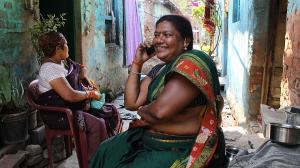 “I keep one mobile phone for the family and one for the clients,” said Renuka Kale, a sex worker in her late twenties living in Sangli district in south Maharashtra and an activist with VAMP* (Veshya Anyay Mukti Parishad, also known as the Sex Workers’ Collective Against Injustice). The two phones are a curious metaphor to the dual life she lives. To hide her identity as a street-based sex worker, she has told her family she does odd jobs or works as domestic help.
“I keep one mobile phone for the family and one for the clients,” said Renuka Kale, a sex worker in her late twenties living in Sangli district in south Maharashtra and an activist with VAMP* (Veshya Anyay Mukti Parishad, also known as the Sex Workers’ Collective Against Injustice). The two phones are a curious metaphor to the dual life she lives. To hide her identity as a street-based sex worker, she has told her family she does odd jobs or works as domestic help.
Renuka was among the 20-odd sex workers who had trickled in at the VAMP drop-in centre located in Miraj’s shanty-lined red light district, 11 kilometres from Sangli city. Most of them were unlettered, and spoke Marathi or Kannada or both. They sat clutching their mobiles phones — rugged models of Nokia, inexpensive feature phones and touchscreen Android phones of Indian brands. Mobile phones, they said, have changed the nature of business.
Street-based sex workers such as Renuka manage all business over the phone. Clients arrange their visits after confirming the sex workers’ availability via mobile phones. Sex workers communicate easily with outstation clients and their maalaks (literally meaning “masters”, often regular customers who have graduated into lovers), without the fear of prying eyes. Being constantly connected also helps build client relations, so to speak. “When I go out of town, my clients call and ask, ‘How long will you stay there? Come back’,” beamed Bharati Kamble. They share their joys and sorrows with their lovers over the phone; the conversation isn’t always about sex.
Read the full article in GenderIT.org .